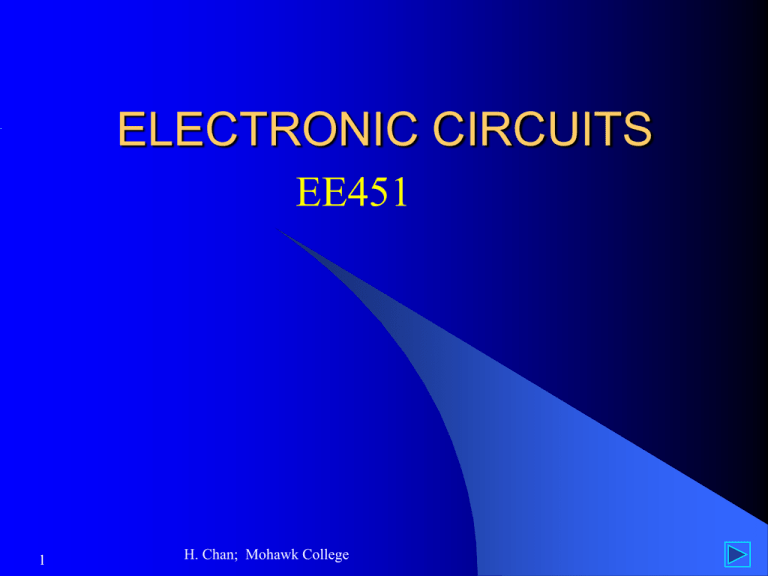electronic circuits
advertisement

ELECTRONIC CIRCUITS EE451 1 H. Chan; Mohawk College MAIN TOPICS (2nd half) Analog & Switching Power Supplies Review of rectification & filtering Review of zener diode as a voltage regulator Transistor series shunt voltage regulators Transistor current regulators IC voltage regulators (e.g. 78/79XX, LM317) Switching-mode regulators (e.g. LH1605) Linear Integrated Circuit Applications BiFET & Norton op-amps, 555 timer, 8038 function generator, active filters, etc. H. Chan; Mohawk College 2 Power Supply Block Diagram H. Chan; Mohawk College 3 Half-Wave Rectifier VP 2 VS 0.7 0.00833 Vdc VP 1 R L CF V t H. Chan; Mohawk College 0.0048VP Vr R L CF 4 Full-Wave Rectifier VP 0.707Vs 0.7 0.00417 Vdc VP 1 R LCF V t H. Chan; Mohawk College 0.0024VP Vr R L CF 5 Bridge-Type Rectifier VP 2 Vs 1.4 0.00417 Vdc VP 1 R LCF V t H. Chan; Mohawk College 0.0024VP Vr R L CF 6 More Equations . . . Rearranging the previous equations: VP = Vdc + 1.736 Vr The ripple voltage as a percentage of the dc voltage is: Vr % ripple x100 Vdc The diode(s) must be rated to withstand the surge current: I surge VP RW where RW is the transformer winding’s resistance given by: VNL VFL RW I FL H. Chan; Mohawk College 7 Comparison of Different Types of Rectifiers Half-wave rectifier needs only a single diode but ripple is twice those of the other types. Full-wave rectifier requires a centre-tapped transformer and its output voltage is about half those of the other types. Bridge-type rectifier is best overall even though it requires four diodes because the diode bridge is often available in a single package. However, if a single diode in the bridge is defective, the whole package has to be replaced. H. Chan; Mohawk College 8 Line Regulation is a measure of the effectiveness of a voltage regulator to maintain the output dc voltage constant despite changes in the supply voltage. Vo Line regulation(m V / V ) Vi Vo 100 % line regulation x Vi Vo H. Chan; Mohawk College 9 Load Regulation is a measure of the ability of a regulator to maintain a constant dc output despite changes in the load current. Vo Load regulation(m V / A) I L Vo 100 % load regulation x I L Vo H. Chan; Mohawk College 10 Other Specifications A common definition for voltage regulation is: VNL VFL Voltageregulation(%) x100 VFL The ability to reduce the output ripple voltage is: Ripplerejection (dB) 20log Vr (out ) Vr (in) Vo or m Source resistance of regulator is: Rs I L H. Chan; Mohawk College 11 Zener Diode Voltage Regulator I-V Characteristic Circuit IZM H. Chan; Mohawk College 12 Notes on Zener Diode Regulator VZ depends on I and temperature. Zener diodes with rated voltage < 6 V have negative temperature coefficient; those rated > 6 V have positive temperature coefficient. In order to maintain a constant Vo, IZT varies in response to a change of either IL or Vi. For example, when RL increases, IL decreases, then IZT has to increase to keep the current through Rs constant. Since the voltage drop across Rs is constant, Vo stays constant. H. Chan; Mohawk College 13 Formulae for Zener Regulator Circuit Rs establishes the zener bias current, IZT: Vi VZ Vi VZ Rs I Rs I ZT I L For fixed Vi, but variable RL: RsVZ VZ min. RL I Rs Vi VZ max. RL VZ I L (min) H. Chan; Mohawk College VZ I Rs I ZM 14 Formulae (cont’d) For fixed RL, but variable Vi: RL Rs min .Vi VZ RL max.Vi I R (max) Rs VZ where I R (max) I ZM I L The output ripple voltage of the zener regulator is: Vr ( out ) RL // RZ Vr (in) where RZ = ac resistance of zener diode. RL // RZ Rs H. Chan; Mohawk College 15 Transistor Series Voltage Regulator The simple zener regulator can be markedly improved by adding a transistor. Since VBE = VZ - VL any tendency for VL to decrease or increase will be negated by an increase or decrease in IE. The dc currents for the circuit are: Vi VZ VL VZ VBE IL ; IR RL RL R IL = hFEIB; IZT = IR - IB H. Chan; Mohawk College 16 Transistor Shunt Voltage Regulator Since VBE = VL - VZ, any tendency for VL to increase or decrease will result in a corresponding increase or decrease in IRs. This will oppose any changes in VL because VL = Vi - IRsRs. VL VZ VBE Vi (VZ VBE ) IL ; I Rs RL RL RS IE = IRs - IL = hFEIZT H. Chan; Mohawk College 17 Op-Amp Voltage Regulators Series Shunt R2 VZ Vo 1 R3 H. Chan; Mohawk College 18 Notes on Op-Amp Voltage Regulator More flexibility possible in design of voltage output than IC voltage regulator packages. The essential circuit elements are: a zener reference, a pass or shunt transistor, a sensing circuit, and an error/amplifier circuit. Equation indicates that Vo depends on R2, R3, and VZ. The shunt configuration is less efficient but R2 offers short-circuit current limiting. H. Chan; Mohawk College 19 Constant Current Limiting can be used for short-circuit or overload protection of the series voltage regulator. Output current is limited to: 0.7 I L (max) R4 H. Chan; Mohawk College 20 Fold-back Current Limiting is a better method of short-circuit protection. VBE 2 R6 VB 2 Vo (Vo I L R4 ) Vo R5 R6 H. Chan; Mohawk College 21 Design Equations for Fold-back Current Limiting Maximum load current without fold-back limiting: R5Vo 0.7( R5 R6 ) I L (max) R4 R6 Output voltage under current limiting condition: 0.7( R5 R6 ) RL Vo ' R 4 R6 R5 RL The short circuit current (i.e. when Vo = 0) is: 0.7( R5 R6 ) I short R4 R6 H. Chan; Mohawk College 22 Characteristics of Fold-back Limiting Vo IL Notice that Ishort < IL(max) and that Vo is regulated (i.e. constant) only after RL > a certain critical value. For designing purpose, R5 + R6 = 1 k and if Ishort and IL(max) are specified then 07Vo R4 I short (Vo 0.7) 0.7 I L (max) H. Chan; Mohawk College 23 Transistor Current Regulators are designed to maintain a fixed current through a load for variations in either Vi or RL. For the BJT circuit, VEB = VZ - VRE. Any tendency for IL to change will cause an opposing change in VEB, thus nullifying the perturbation. For the JFET circuit, IL = ID = IDSS as long as VL < VSS - VP. H. Chan; Mohawk College 24 IC Voltage Regulators There are basically two kinds of IC voltage regulators: Multipin type, e.g. LM723C 3-pin type, e.g. 78/79XX Multipin regulators are less popular but they provide the greatest flexibility and produce the highest quality voltage regulation 3-pin types make regulator circuit design simple H. Chan; Mohawk College 25 Multipin IC Voltage Regulator The LM723 has an equivalent circuit that contains most of the parts of the op-amp voltage regulator discussed earlier. It has an internal voltage reference, error amplifier, pass transistor, and current limiter all in one IC package. LM 723C Schematic H. Chan; Mohawk College 26 Notes on LM723 Voltage Regulator Can be either 14-pin DIP or 10-pin TO-100 can May be used for either +ve or -ve, variable or fixed regulated voltage output Using the internal reference (7.15 V), it can operate as a high-voltage regulator with output from 7.15 V to about 37 V, or as a low-voltage regulator from 2 V to 7.15 V Max. output current with heat sink is 150 mA Dropout voltage is 3 V (i.e. VCC > Vo(max) + 3) H. Chan; Mohawk College 27 LM723 in High-Voltage Configuration Design equations: Vo Vref ( R1 R2 ) R1R2 R3 R1 R2 External pass transistor and current sensing added. H. Chan; Mohawk College R2 Rsens 0.7 I max Choose R1 + R2 = 10 k, and Cc = 100 pF. To make Vo variable, replace R1 with a pot.28 LM723 in Low-Voltage Configuration I L (max) R 4 Vo 0.7(R 4 R 5 ) R 5 R sens I short R sens With external pass transistor and foldback current limiting R 2 Vref Vo R1 R 2 H. Chan; Mohawk College 0.7(R 4 R 5 ) R 5 R sens 0.7Vo Ishort (Vo 0.7) 0.7I L (max) Under foldback condition: 0.7R L (R 4 R 5 ) Vo ' R 5 R sens R 4 R L 29 Three-Terminal Fixed Voltage Regulators Less flexible, but simple to use Come in standard TO-3 (20 W) or TO-220 (15 W) transistor packages 78/79XX series regulators are commonly available with 5, 6, 8, 12, 15, 18, or 24 V output Max. output current with heat sink is 1 A Built-in thermal shutdown protection 3-V dropout voltage; max. input of 37 V Regulators with lower dropout, higher in/output, and better regulation are available. 30 H. Chan; Mohawk College Basic Circuits With 78/79XX Regulators Both the 78XX and 79XX regulators can be used to provide +ve or -ve output voltages C1 and C2 are generally optional. C1 is used to cancel any inductance present, and C2 improves the transient response. If used, they should preferably be either 1 mF tantalum type or 0.1 mF mica type capacitors. H. Chan; Mohawk College 31 Dual-Polarity Output with 78/79XX Regulators H. Chan; Mohawk College 32 78XX Regulator with Pass Transistor 0.7 R1 I max 0.7 R2 I R2 H. Chan; Mohawk College Q1 starts to conduct when VR2 = 0.7 V. R2 is typically chosen so that max. IR2 is 0.1 A. Power dissipation of Q1 is P = (Vi - Vo)IL. Q2 is for current limiting protection. It conducts when VR1 = 0.7 V. Q2 must be able to pass max. 1 A; but note that max. VCE2 is only 1.4 V. 33 78XX Floating Regulator Vo Vreg Vreg I Q R2 R1 or H. Chan; Mohawk College It is used to obtain an output > the Vreg value up to a max.of 37 V. R1 is chosen so that R1 0.1 Vreg/IQ, where IQ is the quiescent current of the regulator. R2 R1 (Vo Vreg ) Vreg I Q R1 34 3-Terminal Variable Regulator The floating regulator could be made into a variable regulator by replacing R2 with a pot. However, there are several disadvantages: Minimum output voltage is Vreg instead of 0 V. IQ is relatively large and varies from chip to chip. Power dissipation in R2 can in some cases be quite large resulting in bulky and expensive equipment. A variety of 3-terminal variable regulators are available, e.g. LM317 (for +ve output) or LM 337 (for -ve output). H. Chan; Mohawk College 35 Basic LM317 Variable Regulator Circuits (a) Circuit with capacitors to improve performance H. Chan; Mohawk College (b) Circuit with protective diodes 36 Notes on Basic LM317 Circuits The function of C1 and C2 is similar to those used in the 78/79XX fixed regulators. C3 is used to improve ripple rejection. Protective diodes in circuit (b) are required for high-current/high-voltage applications. Vo Vref R2 where Vref = 1.25 V, and Iadj is Vref I adj R2 the current flowing into the adj. R1 terminal (typically 50 mA). R1 (Vo Vref ) Vref I adj R1 R1 = Vref /IL(min), where IL(min) is typically 10 mA. H. Chan; Mohawk College 37 Other LM317 Regulator Circuits Circuit with pass transistor and current limiting H. Chan; Mohawk College Circuit to give 0V min. output voltage 38 Block Diagram of Switch-Mode Regulator It converts an unregulated dc input to a regulated dc output. Switching regulators are often referred to as dc to dc converters. H. Chan; Mohawk College 39 Comparing Switch-Mode to Linear Regulators Advantages: 70-90% efficiency (about double that of linear ones) can make output voltage > input voltage, if desired can invert the input voltage considerable weight and size reductions, especially at high output power Disadvantages: More complex circuitry Potential EMI problems unless good shielding, lowloss ferrite cores and chokes are used H. Chan; Mohawk College 40 General Notes on Switch-Mode Regulator The duty cycle of the series transistor (power switch) determines the average dc output of the regulator. A circuit to control the duty cycle is the pulse-width modulator shown below: H. Chan; Mohawk College 41 General Notes cont’d . . . The error amplifier compares a sample of the regulator Vo to an internal Vref. The difference or error voltage is amplified and applied to a modulator where it is compared to a triangle waveform. The result is an output pulse whose width is proportional to the error voltage. Darlington transistors and TMOS FETs with fT of at least 4 MHz are often used. TMOS FETs are more efficient. A fast-recovery rectifier, or a Schottky barrier diode (sometimes referred to as a catch diode) is used to direct current into the inductor. For proper switch-mode operation, current must always be present in the inductor. H. Chan; Mohawk College 42 Step-Down or Buck Converter When the transistor is turned ON, VL is initially high but falls exponentially while IL increases to charge C. When the transistor turns OFF, VL reverses in polarity to maintain the direction of current flow. IL decreases but its path is now through the forward-biased diode, D. Duty cycle is adjusted according to the level of Vo. H. Chan; Mohawk College 43 V & I Waveforms for Buck Regulator PWM output VL IL Vo Normal H. Chan; Mohawk College Low Vo High Vo 44 Equations for Buck Regulator Vo ton ton Vi ton toff T Selecting IL = 0.4Io where Io is the max. dc output current: 2.5Vo (Vi Vo ) L I oVi f osc 0.05I o 0.01768I o C or V pp f osc Vrms f osc where V is the ripple voltage H. Chan; Mohawk College 45 Notes on Operation of Buck Regulator When IL = 0.4Io was selected, the average minimum current, Imin, that must be maintained in L for proper regulator operation is 0.2Io. If IL is chosen to be 4% instead of 40% of Io, the 2.5 factor in the equation for L becomes 25 and Imin becomes 0.02Io. L and C are both proportional to 1/fosc; hence, the higher fosc is the smaller L and C become. But for predictable operation and less audible noise, fosc is usually between 50kHz to 100 kHz. H. Chan; Mohawk College 46 Step-Up, Flyback, or Boost Regulator Assuming steady-state conditions, when the transistor is turned ON, L reacts against Vin. D is reverse-biased and C supplies the load current. When the transistor is OFF, VL reverses polarity causing current to flow through D and charges C. Note that Vout is > Vin because VL adds on to Vin. H. Chan; Mohawk College 47 Equations for Boost Regulator Vo Vi ton Vo T Assuming IL = 0.4Io: 2.5Vi (Vo Vi ) L I oVo2 f osc 2 (Vo Vi ) I o 0.3536(Vo Vi ) I o C or f oscVo V pp f oscVo Vrms H. Chan; Mohawk College 48 Voltage-Inverting or Buck-Boost Regulator Vo can be either step-up or step-down and its polarity is opposite to input. During ON period, Vin is across L, and D is reversebiased. During OFF period, VL reverses polarity causing current to flow through C and D. H. Chan; Mohawk College 49 Equations for Buck-Boost Regulator Vo ton Vi Vo T For IL = 0.4Io: 2.5ViVo L I o (Vo Vi ) f osc I oVo 0.3536I oVo C or Vpp (Vi Vo ) f osc Vrms (Vi Vo ) f osc H. Chan; Mohawk College 50 Basic Push-Pull Power Converter Operates as a class D power amplifier. Output rectifier converts the square-wave to dc. Each transistor must withstand 2xVin plus voltage spikes. 51 H. Chan; Mohawk College Basic Half-Bridge Power Converter Each transistor “sees” approx. Vin. Full flux reversal in the transformer and capacitors across DS prevent voltage spikes. H. Chan; Mohawk College 52 Basic Full-Bridge Power Converter Either Q1 & Q3 or Q2 & Q4 are turned ON simultaneously. Ideal for high power applications. H. Chan; Mohawk College 53 Single-Package Switch-Mode Regulator The LH1605 is a 5A step-down switching regulator. Vo is adjustable from 3 to 30 V by using a pot. for R1. In the circuit above, Q1 turns ON when voltage across Rsens is 0.7 V. Q2 then turns ON shorting Vref to ground and driving Vo to zero. . H. Chan; Mohawk College 54 Equations for LH1605 Switching Regulator Vo 2.5 0.00125R1 or R1 800Vo 2000 With IL = 0.4Io: 1 CT 40000f osc 2.5Vo (Vi Vo ) L I oVi f osc 0.01768I o 0.05I o C or Vrms f osc V pp f osc Rsens 0.7 I max Typically, CF = CC = 10 mF; RB = 10 k H. Chan; Mohawk College 55 BiFET IC Operational Amplifier Advantages of TL081 vs bipolar op-amp (LM741): higher input impedance (typically 1012 ) wider unity-gain bandwidth (3 MHz) higher slew rate (13 V/ms typical) lower offset current (5 pA) lower bias current (30 pA) lower power consumption (1.4 mA supply current) All other parameters are comparable to bipolar op-amps. H. Chan; Mohawk College 56 Frequency Compensation Most op-amps contain a small internal compensating capacitor (15 to 30 pF) for ensuring stability at the expense of bandwidth. For a specific application requiring a wider bandwidth, an uncompensated op-amp, such as the TL080, may be chosen with a small external compensating capacitor. Two commonly used methods are: conventional compensation and feed-forward compensation. The latter method can increase the BW 5 to 10 x. H. Chan; Mohawk College 57 Circuits for Frequency Compensation Conventional C1 is typ.10 to 20 pF H. Chan; Mohawk College Feed-forward C1 is typ. 100 to 150 pF 58 Response With Frequency Compensation Av With feed-forward compensation Increase in BW With normal compensation 1k 10k 100k Hz H. Chan; Mohawk College 1M 10M f 59 Astable Multivibrator or Relaxation Oscillator Circuit Output waveform H. Chan; Mohawk College 60 Equations for Astable Multivibrator VUT Vsat R2 Vsat R2 ; VLT R1 R2 R1 R2 R1 2 R2 where Assuming |+Vsat| = |-Vsat| T t1 t 2 2 ln R1 = RfC If R2 is chosen to be 0.86R1, then T = 2RfC and 1 f 2R f C H. Chan; Mohawk College 61 Monostable (One-Shot) Multivibrator Circuit H. Chan; Mohawk College Waveforms 62 Notes on Monostable Multivibrator Stable state: vo = +Vsat, VC = 0.6 V Transition to timing state: apply a -ve input pulse such that |Vip| > |VUT|; vo = -Vsat. Best to select RiCi 0.1RfC. Timing state: C charges negatively from 0.6 V through Rf. Width of timing pulse is: t R C ln | Vsat | 0.6 p f | V | V LT sat If we pick R2 = R1/5, then tp = RfC/5. Recovery state: vo = +Vsat; circuit is not ready for retriggering until VC = 0.6 V. The recovery time tp. To speed up the recovery time, RD (= 0.1Rf) & CD can be added. H. Chan; Mohawk College 63 Norton or Current-Mode Op-Amp Simplified circuit H. Chan; Mohawk College Amplifies I (= I- - I+) between the inputs. Q3 and D1 form a current mirror (ICQ3 ID1). In practice, two matched transistors are used; the 1st transistor connected as a diode. Current into base of Q1 IB1 = I. Note that VB 0.7 for both Q1 & Q2. 64 Notes on LM3900 Op-Amp Comes in a standard 14-pin DIP quad package. Can operate from a single supply (4 to 32 V) or dual supplies (±2 to ±16 V). Rin = 1 M, Rout = 8 k Aol = 2800 Unity-gain bandwidth = 2.5 MHz (much better than the LM741) Not as widely used as voltage op-amps because circuit designers are less familiar with it. H. Chan; Mohawk College 65 Norton Amplifiers Design equations for inverting and non-inverting amplifiers are exactly the same: Zin = RI ; Inverting Non-inverting RF Av RI Neglecting RS and Ro: 1 Cin 2f cL RI Cout H. Chan; Mohawk College 1 2f cL RL 66 Other Design Equations for Norton Amplifier The dc output offset voltage: Voffset RF (VCC 0.7) 0.7 RB For max. swing, Voffset = VCC/2, thus (VCC 0,7) RF RB VCC / 2 0.7 Note that if dual polarity supply is used, Voffset can be made to be 0V and Cout would not be required for both circuits. H. Chan; Mohawk College Since max. Iin = 20 mA dc, VCC 0.7 RB (min) 0.02 VCC 1.4 RF (min) 0.04 Also, min. input bias current is 200 nA, VCC 0.7 RB (max) 200nA VCC 1.4 RF (max) 400nA 67 Functional Block Diagram of LM555 H. Chan; Mohawk College 68 Notes on 555 Timer/Oscillator IC Widely used as a monostable or astable multivibrator. Can operate between 4.5 and 16 V. Output voltage is approximately 2 V < VCC. Output can typically sink or source 200 mA. Max. output frequency is about 10 kHz. fo varies somewhat with VCC. Threshold input (pin 6) and trigger input (pin 2) are normally tied together to external timing RC. H. Chan; Mohawk College 69 555 as a Simple Oscillator Duty cycle is: tch R1 R2 D T R1 2R2 Given fo and D, 2D 1 1 D R1 ; R2 0.693f oC1 0.693f oC1 tch = 0.693(R1 + R2)C1 tdisch = 0.693 R2C1 T = 0.693(R1 + 2R2)C1 H. Chan; Mohawk College Note that D must always be > 0.5. To get 50% duty cycle, R1 = 0, which would short out VCC. 70 555 Square-Wave Oscillator R1 D R1 R2 R1 D 1 D ; R2 0.693f oC1 0.693f oC1 For 50% duty cycle, tch = 0.693 R1C1 ; tdisch = 0.693 R2C1 1 fo 0.693( R1 R2 )C1 H. Chan; Mohawk College 1 R1 R2 1.386 f oC1 71 555 as a Timer / Monostable Multivibrator t = 1.1 R1C1 Time pulses from a few ms to many minutes are possible. The main limitation for very long time delays is the leakage in the largevalue capacitor required for C1. R2 (typically 10 k) is a pull-up resistor. C2 (typically 0.001 mF) is for bypass. Timing starts when trigger input is grounded. H. Chan; Mohawk College 72 ICL8038 Function Generator IC H. Chan; Mohawk College Triangle wave at pin10 is obtained by linear charge and discharge of C by two current sources. Two comparators trigger the flip-flop which provides the square wave and switches the current sources. Triangle wave becomes sine wave via the sine converter . 73 Notes on ICL8038 IC To obtain a square wave output, a pull-up resistor (typically 10 to 15 k) must be connected between pin 9 and VCC. Triangle wave has a linearity of 0.1 % or better and an amplitude of approx. 0.3(VCC-VEE). Sine wave can be adjusted to a distortion of < 1% with amplitude of 0.2(VCC-VEE). The distortion may vary with f (from 0.001 Hz to 200 kHz). IC can operate from either single supply of 10 to 30 V or dual supply of 5 to 15 V. H. Chan; Mohawk College 74 ICL8038 Function Generator Circuit fo 3(VCC Vsweep ) 2 RC1Vtotal where R = RA = RB If pin 7 is tied to pin 8, fo 3 RA 5RAC1 1 2 RA RB For 50 % duty cycle, +VCC > Vsweep > Vtotal + VEE + 2 where Vtotal = VCC + |VEE| H. Chan; Mohawk College fo 0.3 RC1 75 Active Filters Active filters use op-amp(s) and RC components. Advantages over passive filters: op-amp(s) provide gain and overcome circuit losses increase input impedance to minimize circuit loading higher output power sharp cutoff characteristics can be produced simply and efficiently without bulky inductors Single-chip universal filters (e.g. switchedcapacitor ones) are available that can be configured for any type of filter or response. H. Chan; Mohawk College 76 Review of Filter Types & Responses 4 major types of filters: low-pass, high-pass, band pass, and band-reject or band-stop 0 dB attenuation in the passband (usually) 3 dB attenuation at the critical or cutoff frequency, fc (for Butterworth filter) Roll-off at 20 dB/dec (or 6 dB/oct) per pole outside the passband (# of poles = # of reactive elements). Attenuation at any frequency, f, is: f atten. (dB) at f log x atten. (dB) at f dec fc H. Chan; Mohawk College 77 Review of Filters (cont’d) Bandwidth of a filter: BW = fcu - fcl Phase shift: 45o/pole at fc; 90o/pole at >> fc 4 types of filter responses are commonly used: Butterworth - maximally flat in passband; highly nonlinear phase response with frequecny Bessel - gentle roll-off; linear phase shift with freq. Chebyshev - steep initial roll-off with ripples in passband Cauer (or elliptic) - steepest roll-off of the four types but has ripples in the passband and in the stopband H. Chan; Mohawk College 78 Frequency Response of Filters A(dB) A(dB) LPF A(dB) HPF BPF Passband fc f f fc A(dB) fcl f fcu A(dB) Butterworth BRF Chebyshev Bessel fcl fcu f H. Chan; Mohawk College f 79 Unity-Gain Low-Pass Filter Circuits 2-pole 3-pole 4-pole H. Chan; Mohawk College 80 Design Procedure for Unity-Gain LPF Determine/select number of poles required. Calculate the frequency scaling constant, Kf = 2f Divide normalized C values (from table) by Kf to obtain frequency-scaled C values. Select a desired value for one of the frequency-scaled C values and calculate the impedance scaling factor: frequency scaled C value Kx desired C value Divide all frequency-scaled C values by Kx Set R = Kx H. Chan; Mohawk College 81 An Example Design a unity-gain LP Butterworth filter with a critical frequency of 5 kHz and an attenuation of at least 38 dB at 15 kHz. The attenuation at 15 kHz is 38 dB the attenuation at 1 decade (50 kHz) = 79.64 dB. We require a filter with a roll-off of at least 4 poles. Kf = 31,416 rad/s. Let’s pick C1 = 0.01 mF (or 10 nF). Then C2 = 8.54 nF, C3 = 24.15 nF, and C4 = 3.53 nF. Pick standard values of 8.2 nF, 22 nF, and 3.3 nF. Kx = 3,444 Make all R = 3.6 k (standard value) H. Chan; Mohawk College 82 Unity-Gain High-Pass Filter Circuits 2-pole 3-pole 4-pole H. Chan; Mohawk College 83 Design Procedure for Unity-Gain HPF The same procedure as for LP filters is used except for step #3, the normalized C value of 1 F is divided by Kf. Then pick a desired value for C, such as 0.001 mF to 0.1 mF, to calculate Kx. (Note that all capacitors have the same value). For step #6, multiply all normalized R values (from table) by Kx. E.g. Design a unity-gain Butterworth HPF with a critical frequency of 1 kHz, and a roll-off of 55 dB/dec. (Ans.: C = 0.01 mF, R1 = 4.49 k, R2 = 11.43 k, R3 = 78.64 k.; pick standard values of 4.3 k, 11 k, and 75 k). H. Chan; Mohawk College 84 Equal-Component Filter Design 2-pole LPF Same value R & same value C are used in filter. Select C (e.g. 0.01 mF), then: 1 R 2f oC 2-pole HPF Av for # of poles is given in a table and is the same for LP and HP filter design. RF Av 1 RI H. Chan; Mohawk College 85 Example Design an equal-component LPF with a critical frequency of 3 kHz and a roll-off of 20 dB/oct. Minimum # of poles = 4 Choose C = 0.01 mF; R = 5.3 k From table, Av1 = 1.1523, and Av2 = 2.2346. Choose RI1 = RI2 = 10 k; then RF1 = 1.5 k, and RF2 = 12.3 k . Select standard values: 5.1 k, 1.5 k, and 12 k. H. Chan; Mohawk College 86 BPF fcl fctr fcu f Attenuation (dB) Attenuation (dB) Bandpass and Band-Rejection Filter BRF fcl The quality factor, Q, of a filter is given by: where BW = fcu - fcl and f ctr fctr f fcu f ctr Q BW f cu f cl H. Chan; Mohawk College 87 More On Bandpass Filter If BW and fcentre are given, then: 2 BW 2 BW BW BW 2 2 f cl f ctr ; f cu f ctr 4 2 4 2 A broadband BPF can be obtained by combining a LPF and a HPF: The Q of this filter is usually > 1. H. Chan; Mohawk College 88 Broadband Band-Reject Filter A LPF and a HPF can also be combined to give a broadband BRF: 2-pole band-reject filter H. Chan; Mohawk College 89 Narrow-band Bandpass Filter f ctr 1 BW Q 2R1C C1 = C2 = C R2 = 2 R1 R1 R3 2Q 2 1 f ctr 1 R1 1 R3 2 2R1C R3 can be adjusted or trimmed to change fctr without affecting the BW. Note that Q < 1. H. Chan; Mohawk College 90 Narrow-band Band-Reject Filter Easily obtained by combining the inverting output of a narrow-band BRF and the original signal: The equations for R1, R2, R3, C1, and C2 are the same as before. RI = RF for unity gain and is often chosen to be >> R1. H. Chan; Mohawk College 91








